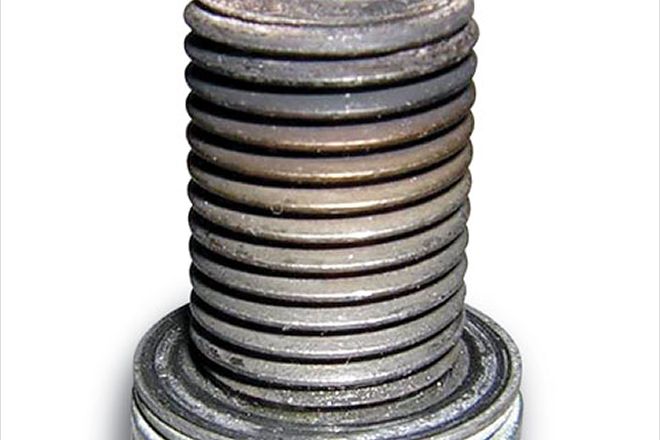
 Ken Brubaker
Senior Editor, Four Wheeler
Photographers:
Bosch Corporation and E3 Spark Plugs
Ken Brubaker
Senior Editor, Four Wheeler
Photographers:
Bosch Corporation and E3 Spark Plugs
We all know that an automotive spark plug is a device that forces a high-voltage charge of electricity to arc across a gap, thus igniting the air/fuel mixture in the combustion chamber. What may come as a surprise is twofold. First, simply inspecting these little devices can be used to help diagnose engine issues. Seriously. Second, spark-plug technology has grown exponentially over the past several years to a point where simply installing a high-tech set of plugs can make a positive difference in your rig's power and fuel economy. Let's take a look.
Part 1: Engine DiagnosisJust as Jimmy Nylund found that analyzing engine oil can uncover important internal engine information ("Oil Analysis," Sept. '06), inspecting your spark plugs can reveal a lot about what's going on inside your engine. After the plugs have been used in an engine for several thousand miles, they harbor telltale data. The plug face (electrode end) can offer insight into the overall condition of items such as piston rings and valve seals. They can also help identify issues with things like the carburetor, injectors, valves, or vacuum advance. The plugs can allow you to diagnose a variety of fouling scenarios as well as pre-ignition, overheating, low operating temperature, gap bridging, plugs with the wrong heat range, or even some general mechanical damage. Here are some commonly found problems and causes:
Ash-fouled: Loose to cinder-like heavy ash deposits on the insulator nose. Alloying constituents, particularly from engine oil, can deposit this ash in the combustion chamber and on the plug face. This can lead to auto-ignition, with loss of power and possible engine damage. If the engine isn't damaged, you can change the oil and fit new plugs.
Over-rich fuel condition: This is generally indicated by black and fluffy soot on the insulator. It can indicate a leaking injector or an out-of-adjustment carburetor. This can cause low fuel economy, decreased performance, and even damage to the catalytic converter.
Partially melted center electrode: Can be caused by the ignition being too far advanced, combustion deposits in the combustion chamber, a defective distributor, incorrect air/fuel mixture, or poor-quality fuel. Can result in misfiring, loss of power, and insulator-nose breakage.
Heavy wear on the ground electrode: This can be caused by fuel and oil additives or poor flow conditions in the combustion chamber due to combustion deposits. Because the ground electrode has worn, the gap is far too large and the ignition voltage is no longer sufficient for the large electrode gap. This can cause misfiring and poor starting.
Side electrode bent or moved: The plug contacted either the valve or piston. Using the wrong plug generally causes this. Always use the plug recommended for your vehicle.
Oil-fouled: Oil is entering the combustion chamber. This can manifest itself as either an oil-covered face or by white deposits on the insulator. Causes can be scored cylinder walls, badly worn piston rings, and/or worn valve guides and seals.
Lead-fouled: You'll find a brown/yellow glazing on the insulator nose. At high loads, the glazing becomes conductive and causes misfiring. Caused by lead additives in fuel.
Cracked insulator nose: Most of the time this is caused by mishandling the plug vis--vis dropping it, although overuse can also cause this. The result can be that the spark arcs at a point that is inaccessible for the fresh charge of air/fuel mixture, thus causing a misfire.
Since some problems can be cylinder-specific, it's important to keep track of what plug came out of what cylinder. Remember that if the engine is in good shape, all of the plugs should exhibit the same electrode erosion and light tan or gray color. Plugs that differ in appearance are indicative of a problem with a given cylinder. However, all of the plugs may show the same problem, if let's say, a throttle body or carburetor is misadjusted or faulty. The upside is that by reading your spark plugs, you may catch a problem in the early stages before it leaves you stranded or your wallet drained.
Part 2: Plugs Go High-TechA plug is a plug, right? Well, that may have been true 20 years ago, but over the past several years' spark-plug technology has made a gargantuan leap forward as manufacturers have worked to improve the ignition of fuel inside the combustion chamber. The result is a variety of plugs, many of which are infused with fascinating technology. Just as the Big Three have a slightly different way of designing their fullsize pickups, for instance, spark-plug manufacturers seem to approach their plugs differently. Some are designed for longevity while others tout improved performance. The common denominator nowadays seems to include high-tech electrodes as well as super-conductive materials that last longer and help create larger, more powerful flame kernels. What this means to us 'wheelers is more power and better fuel economy by simply screwing in some plugs. Following are two examples of the latest spark-plug technology.
Bosch Platinum Plugs
Bosch introduced its first platinum plug to the North American market in 1985, thus creating the premium spark-plug segment. The platinum plug features a center electrode that is 99.9 percent pure platinum. Platinum, in case you're not aware, improves corrosion- and erosion-resistance; broadens the heat range beyond that achieved with copper-core plugs; offers extremely consistent, reliable performance; and boasts a longer performance life than plugs with a standard copper core. Since then, the Bosch family of platinum spark plugs has grown to include the Platinum, Platinum2, and Platinum+4. In addition to the use of platinum, the Bosch plugs are unique in that each plug is manufactured using an exclusive process where the platinum center electrode is sintered, or heat-fused, into a unique extended ceramic insulator. This results in the world's only spark-plug design in which the air gap between the center electrode and the insulator is eliminated. There are two advantages to this. First, the plug is able to reach its self-cleaning temperature within seconds. Second, it better maintains its optimal operating temperature, which results in smoother acceleration and no misfiring. Which Platinum plug you choose depends on what level of performance you wish-and what you want to spend.
E3 DiamondFIRE
E3's new DiamondFIRE plug has a unique electrode with what they call "open architecture." Because sparks naturally follow edge-paths as they leave an object, E3 designed its electrode with multiple sharp edges to the center electrode. The company says sparks flow between these edges at lower voltages, facilitating easier discharge than standard designs. Also note that the design allows free replenishment of the spark zone with a fresh air/fuel charge, and it exposes the flame front more directly to the piston head than other plug designs. Compared to a standard plug, E3's testing has shown increased combustion pressure at each cycle; the fastest flame speed and combustion rise in the industry; a 6 percent improvement in power output on average; a notable reduction in carbon deposits and piston head damage; and reduced fuel usage by 3 to 13 percent, depending on engine class. Further, even though the E3 is constructed of standard materials, test data at 50 hours (20 million firing cycles) showed a strong fall-off in the conventional spark plugs' ability to promote complete combustion, it exhibited degraded power, and worsened fuel consumption as compared to the E3. All testing was validated by Georgia Tech and Michigan State Universities and the Environmental Protection Agency.











